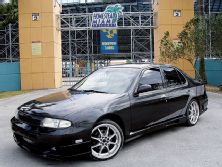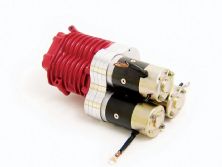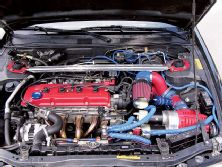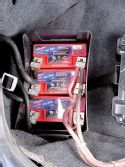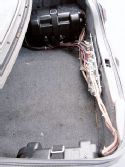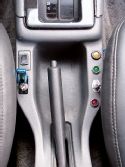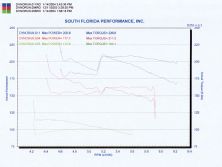Hard case cars are those sport compacts that fall through the cracks in the industry and consequently get zero love in the aftermarket. Nary a bolt-on to be had, these cars rely on the "universal" parts to conjure higher-flowing exhaust systems or intakes. Heck, most owners are lucky to find a good set of tuner wheels.
A lot of these lost souls are out there and for those unfortunates who lust for boost, there's light at the end of the tunnel--the Thomas Knight Turbo electric supercharger. Designed as a universal supercharger, there are no ungodly pulley configurations or whacked-out axle drives to deal with. In fact, Thomas Knight Turbo (TKT) likens the installation to that of a high-flow intake. TKT says that for most FWD cars, relocating the battery to the trunk and swapping out the air filter opens up enough room to install the unit.
The ESC-400 is the result of 26 years of effort. "I built my first ESC in 1978 while working at Turbo Tech, an FAA and industrial turbo repair station," says TKT's Geoff Knight. "A T11 turbo from a wrecked aircraft was being inspected to see if it caused the engine to fail and it was fine. The FAA never allows parts from any crashed plane to see air time again, so this perfect turbo was deemed un-air-worthy." So he bought it for $25--the core value.
An old-time machinist showed Knight how to work the machines there, so he ground off the turbine blades and machined the cartridge for ball bearings. He pressed a 1.5-inch, two-groove pulley on the turbine end of the shaft and installed it into the turbo with the ball bearings. A friend who owned a starter/alternator shop helped him rewind several starters until they made one that produced 5-6 psi spinning 7000 rpm and drew 700 amps at 12V and 400 amps at 24V. Then he mounted a 6-inch, two-groove pulley on it and attached everything to a piece of plywood in the back of his '72 VW Beetle. Running two batteries in series, he routed a 2.5-inch pipe through the rear firewall. It made 6-7 psi at launch and 3 psi at redline. "The VW was fast," says Knight. "Belts flew off every run; no exception. V-belts don't like 30,000 rpm. I tried for years to do better."
In the early '80s, Knight raced electric RC boats. He installed an Astro-Flight 25 plane motor in a 26-inch SK-daddle boat and ran 27 mph on 26 1.2V NiCads. He decided to try for the record--29 mph average for two laps. More batteries didn't help. Two motors and shafts added 3 mph, so he ran 30 mph with that setup. "I then tried three motors, and even four but nothing went faster. I was frustrated!" he remembers.
Knight then raced 11-foot Hydros for a while and met one of the unlimited drivers at a race. He'd done something similar with model gas boats, so the subject moved to why Knight couldn't go faster. "Simple," he replied, "hydrodynamic drag--too much surface area from too many blades." So Knight eliminated all shafts except one, and ran three motors side-by-side with nylon gears connecting them. That made 35 mph on the first try. By then, the top guys were at 40 mph, so he gave up. Too little, too late. But this lesson eventually led to the production ESC.
Through the years, Knight built about 200 different ESC prototypes, but he never had enough electrical power.
In 1996 Knight looked into a 90-hp DC motor, but it was bigger than a car engine and weighed 1000 pounds. He decided to lower the engine size to a reasonable amount. Even a 2.0-liter engine making 15 psi at 8000 rpm required a 30-hp DC motor. Knight looked into smaller motors, which were still too big and heavy.
"In 1998," says Knight, "I remembered the model boat multiple motors, and realized I may have a solution. Two or more motors; three or four. Why not?" So he applied for patents and researched motors. The 4kw brushless model plane motors were $1,000 each, and each supercharger unit cost $4,500 to make. He made one with three model motors drawing 3,500 watts each at 60 volts. This one used a centrifugal supercharger with gears, then belts, etc. Gears were parasitic, and belts were destroyed in a short time.
Frustration set in again, and Knight built one with some 3kw starter motors. These field winding motors had a ton of torque, but grew hot quickly. After rewinding the starters to different levels, he reached 10,000 rpm and 5.0KW per motor. But the belts and other problems made these centrifugal units work only for someone who wouldn't object to replacing bearings and belts all the time.
Knight was desperate. He'd just replaced 12 belts in a few days on the ESC and wasn't happy. He had a twin-rotor M62 at the shop with a bad nose drive, so he removed the bad nose drive from the Eaton and machined an adaptor to bolt it up. He was sure it would be a poor performer, but went ahead and bolted it into the car.
"It was awesome!" Knight says. "Instant boost, with much faster response than the centrifugal design. Boost was higher at first with the curve going down on a linear path."
Now Knight has patents pending on six different designs, and international patents as well. Two years of constant use on the Avenger test mule has proven the Eaton/electric to be indestructible. The Eaton lasts 158K as a belt-driven supercharger. As an ESC they should last 4 million miles. The electric motors have a 1000-hour life expectancy; at 400 seconds per day that's 24 years.
If Thomas Knight Turbos has its way, being "on the juice" will soon have a whole new meaning. TKT has certainly performed the proper due diligence on this one and the ESC-400 has the look of a viable solution to those enthusiasts on the wrong side of the forced-induction fence. Time will tell if this technology catches on.
ESC Q&A
Turbo:Why did you build an electric supercharger?
Thomas KnighT: The idea of a serious electric supercharger has always intrigued me. There are no parasitic losses, the unit can be mounted anywhere in the car and it can be run in any car; it's not application specific.
T: When did you start on your design?
TK: I built my first electric supercharger in 1978. I was working at Turbo Tech in Miami and used an Airesearch T11 airplane turbo combined with an automotive starter. I ground the turbine wheel blades off and fit a small multi-groove V-belt pulley on the shaft with some ball bearings. It worked great on my VW beetle. I mounted it where the back seat was and ran a duct through the firewall to the carb top. An extra car battery in series with the stock battery (24v) made 6 to 7 psi at low rpm, then tapered to 3.5 psi at high rpm. I threw V-belts every 30 seconds or so.
T: Have you designed different types of electric superchargers?
TK: I've built more than 100 different designs with varying success, but the same problem always occurred--not enough boost to make me happy. Four psi is better than nothing, but my goal was 15 psi.
T: When did you develop the idea of using three motors?
TK: About 10 years ago I developed a program to determine the horsepower requirements for electric compressors. It was a very difficult program and it took me a long time to get the parameters correct. I found that flowing 780cfm at 15 psi required 80 to 100 hp. I went smaller on engine size and lowered boost requirements until I reached 450cfm at 8 psi, which required 18 to 22 hp, so I looked for a 20-hp dc motor. All I found were 50-plus-pound motors, which were too large to use in my intended application. Three years ago I realized if I used multiple motors, I could get to the 20-hp mark.
T: Why a Roots-type supercharger?
TK: I designed many different models and applied for the patents. I also have patents pending on screw, roots, centrifugal and sliding vane-type electric superchargers. The centrifugal design is in the works, and the screw is simply too expensive to use. The sliding vane is great but quite large, so the Roots is cost effective, reliable, simple, durable, and provides the quickest boost response.
T: How does your system operate?
TK: The ESC-400 is somewhat like nitrous, as the batteries must be recharged after awhile. Nitrous is great but is quite expensive and filling the bottle is time-consuming. Recharging batteries costs pennies a day. Think of the batteries as the same as a nitrous tank.
T: Can the batteries be charged from the alternator?
TK: Yes*, but see additional notes:
*If the alternator is stock, we suggest four or more standard batteries or Optima batteries, which will provide longer running times. These will be heavy, so you can eventually replace the alternator with a 200-plus-amp unit and switch to the smaller and lighter Odyssey batteries.
*If the alternator is upgraded, battery technology has come so far that a standard car battery can now be replaced with a 13-pound 3x6-inch battery that has more cranking amps than a big conventional battery. Hawker-ODYSSEY has the best units, in our opinion. The additional batteries and the ESC-400 weigh less than the typical complete turbo kit.
T: How long does recharging take?
TK: You can recharge the batteries in a few minutes of steady-state driving with a high-output alternator.
T: How hot does the ESC get?
TK: The delta rise at 5 psi is only 40 to 50 degrees, which is very efficient. If the Eaton isn't ported, those numbers are a lot higher.
T: What do you see for the future with electric superchargers?
TK: Electric supercharger designs will be even better when automotive electrical systems go to 42 volts. The current draw at 42 volts is 350 percent less than at 12 volts, so the discharge/recharge rate will become even closer to 1:1.
T: What size engine will this work on?
TK: Testing has shown the smaller the engine, the higher the sustainable boost. If a 3.5-liter engine is running 24v, boost will peak at 10 psi at 2000 rpm and then drop off to 3 psi at 6500 rpm. A 1750cc engine would make 10 psi at 4000 rpm while dropping off to 3 psi at 13,000 rpm. The boost drop is linear, so that 1750cc engine would make 7-8 psi at redline, and launch at 15 psi using 24 volts. If a blow-off valve is used to bleed off excess pressure, a steady sustainable boost is possible until the capacity of the supercharger is reached. This means that a prepared 1.6-liter four-cylinder can run a sustained 15 psi at 36 volts to 6000 rpm.
Pros
• Belt-driven superchargers require the engine to power the unit. This parasitic loss can be substantial, especially at higher boost levels.
• Turbos are not free power, as some will claim. A turbo is a turbine-driven supercharger and to drive something requires horsepower. The turbine needs velocity, volume, heat and pressure to operate. The first three won't make any boost. It's pressure that makes boost. The first three help with greater efficiency. The pressure in a turbo is measured by the difference in intake manifold pressure and exhaust manifold pressure. This is referred to as the exhaust-to-intake pressure ratio. Most turbos operate at a 2:1-to-3:1 ratio, meaning that if 10 psi is in the intake manifold, the exhaust manifold will see 20 to 30 psi. (The GN operated on a 2.5:1 ratio and the 300ZXTT had a 2.7:1 ratio). Some racecars make PR better than 1:1, but they're still making backpressure. Backpressure is a restriction, and a restriction is not free power.
Cons
• Battery technology and weight are the classic detractors. However, battery technology has advanced significantly in recent years and the lightweight batteries that are available already will become lighter as the technology evolves.
• The system lacks an electronic boost control strategy. This will be available soon.
• Low-output alternators, which can't recharge the batteries quickly enough, can limit ESC running time.
• Wiring must be properly installed. This is key in the overall performance of the unit.
Nissan Altima ESC Development Chronology
12-11-03
Our completely stock Nissan Altima four-cylinder outfitted with an automatic transmission jumped from 105 whp to 184 whp with the ESC-400 at only 5 psi boost.
12-20-03
Moroso Motorsport Park was home this weekend to the Sport Compact Winter Challenge, and we took the Altima to MMP to test the ESC down the quarter mile. The weight of the car with speaker box, molded body kit, ESC-400 and batteries, etc was 3,780 pounds. The stock KADE 2.4-liter four-cylinder automatic ran low 18s at 78 mph with the ESC off, and ran a best 15.583 at 89 mph at only 5 psi boost. Traction with the ESC was a real problem, with 2.45 60-foot times on four attempts. This is faster than a 5.0 Mustang convertible.
1-6-04
Installed the ESC-400DR-550 (drag racing version) in the Altima, prepping it for Moroso on February 8. This unit is capable of 20-plus psi, so we had to set the pressure to 10 psi with the BOV. At 10 psi, it feels like a high 13-second car, and we'll add some parts to support the 10 psi. We're installing headers, an exhaust system and larger injectors. A dyno run is set for next Wednesday at South Florida Performance. We should see well over 200 whp on this stock long-block auto trans Altima.
1-8-04
Oops! Too much boost. Blew something on the Altima. We took some visitors for test rides and some burnout photos, and after more than 30 runs at 10 psi, the engine let go. The fuel cut leaned out the mixture too much. Time to pull the head.
1-10-04
We need pistons. Three pistons were damaged during the last run, and we're swapping another stock engine in the car. The ECU uses a fuel cut-off as a rev limiter, and that caused the engine to run too lean and burn the pistons. Ten psi seems just too high for a stock Altima engine.
1-14-04
Replaced engine with a low-mileage stock engine, added OBX headers, and an extra 550cc injector. The dyno run at a safer 8 psi gave us more than 208 wheel hp at South Florida Performance today! We won't ever run lean again with that 550cc additional injector. Next stop--Moroso February 8. We should run high 13s or low 14s.

